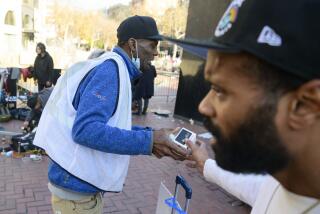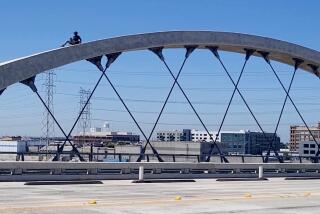A Jump Survivor’s Bridge to Activism
- Share via
SAN FRANCISCO — The very moment John Kevin Hines jumped off the Golden Gate Bridge, he knew he’d made a mistake.
His eyes wet with tears, he had finally consented to the voices that commanded him to take his own life. But at 10:40 a.m. on that overcast September day, just as he catapulted over a 4-foot-high railing and began his frantic free fall, the college freshman asked himself: “What did I just do? I don’t want to die.”
Plummeting head-first toward the churning waters 220 feet below, he tried to scream, but the force of the descent sucked the air from his lungs. He felt an odd euphoria as winds buffeted his body. But to survive, he knew he had to right himself before hitting the water.
At last, the former high school wrestler and football nose tackle tipped his head back, plunging below the surface feet first. Pain raced through his legs as the impact fractured an ankle and shattered two vertebrae in his lower back.
Hines opened his eyes to a murky netherworld, his broken body racked by fierce currents in the 50-degree water. Still, he could see diffuse light above and headed for the surface 40 feet away.
“I remember it like it was yesterday: At the top, I took this huge gasp of air,” he said. “It’s like I was reborn that day.”
Hines was just 19.
Its majestic orange arch spanning San Francisco Bay, the Golden Gate Bridge holds a dubious distinction as one of the world’s most popular suicide spots. Since 1937, bridge officials say, more than 1,300 people have made the leap, not counting those who went unnoticed or whose bodies were quickly swept out to sea.
Only 16 have survived.
Now 23, Hines has a titanium cage in his back. He has twice returned to hospitals to treat a bipolar disorder that causes upsetting mood swings. Yet today he has a mission, unlike the one he had Sept. 25, 2000.
His face freckled, his body weightlifter-sturdy, he takes time from his acting studies to help prevent others from opting for what he calls “a permanent solution to a temporary problem.”
Hines is part of a task force urging officials to erect a suicide barrier on the landmark span. He has spoken to numerous groups about how a barricade would prevent bridge suicides, which now average about one every two weeks.
Officials have long resisted installing a barrier, citing the cost, a fear of compromising the bridge’s profile and doubts over whether determined jumpers wouldn’t just go elsewhere.
Hines knows the terrible allure the bridge holds for the severely depressed.
“Most people see the bridge’s spectacular beauty; the mentally ill see an opportunity for a romantic way out,” he said. “What they choose to ignore is that hitting the water at that speed is a gruesome way to die.”
Hines spent a month in the hospital recovering from his injuries. For a year, he avoided the towering Art Deco span. On the first anniversary of his jump, his father took him back to the site as a way to exorcise his pain.
Facing San Francisco’s gleaming skyscrapers, Hines dropped a purple tulip to the water below. Now he returns every year on the date.
“I was supposed to die,” he said. “I wanted to die. Every day, that jump prompts me to ask, ‘Who am I? Why am I?’ ”
*
A Mounting Suicide Toll
With great fanfare, the Golden Gate Bridge opened May 28, 1937. Within weeks, World War I veteran Harold Wobber became the first suicide statistic with the supposed last words: “This is as far as I go.”
Year by year, the toll mounted. A San Francisco Examiner story after the 500th bridge suicide in 1973 noted that “the jumpers included janitors, attorneys, dishwashers, young mothers, college students, scientists, peddlers, laborers, socialists, businessmen, models, writers, hospital patients, professors, accountants, bankers and swingers.”
The oldest person to go over the rail was an 87-year-old man, the youngest a 5-year-old girl, thrown over by her suicidal father before his own plunge. One couple held hands and jumped together following a last kiss, news accounts say.
Victims are rich and poor, famous and obscure. They include Roy Raymond, founder of Victoria’s Secret and the eldest son of former White House Press Secretary Pierre Salinger. In 1995, Duane Garrett, a fundraiser and friend of Al Gore, was found floating under the bridge.
The span took on a circus atmosphere as the media started countdowns to the 1,000th recorded jumper. A disc jockey promised a case of Snapple to the family of the victim, and local lumberyard workers formed the “Golden Gate Leapers Assn.,” wagering on the day of the next jump, according to bridge historians.
Finally, authorities halted the official count at 997 as mental health experts began educating the public on the trauma suffered by jumpers.
The fall from the bridge -- comparable to a jump off a 25-story building -- lasts four seconds, says psychologist Richard Seiden, the leading researcher on suicide at the Golden Gate. At impact, the body is traveling 75 mph. Ribs and vertebrae often shatter, puncturing lungs and other organs. As with Hines, a jumper’s best chance of survival is to hit the water feet first, at a 45-degree angle.
Assistant Marin County Medical Examiner Gary Tindel, who has autopsied numerous jump victims, says major organs often tear away from tissue and bone. Three of 10 jumpers survive the impact only to drown in the frigid bay waters. Some survivors are left paralyzed.
Like Hines, many survivors regret in midair their decision to jump. Still, depressed people seem drawn to the span. Seiden said jumpers even drive across the Bay Bridge to take their lives from atop the Golden Gate.
Suicide-barrier advocates got a boost in January when moviemaker Eric Steel publicly acknowledged that he had quietly filmed nearly two dozen bridge suicides throughout 2004 for an upcoming documentary.
Since then, Bay Area transportation officials have earmarked $1.6 million of the $2 million needed to study a barrier. The task force seeks to raise the rest.
Psychiatrist Mel Blaustein, task force president, said the span’s bike patrols and emergency phones aren’t enough, pointing out that erection of barriers at the Eiffel Tower and Empire State Building all but ended suicide attempts there.
Although officials haven’t blanched at building a bicycle safety barrier, Hines says, the mentally ill are ignored.
San Francisco Supervisor Tom Ammiano, who sits on a board overseeing the bridge, acknowledged the lack of “political will” to erect a barrier:
“The issue of suicide still makes people uncomfortable.”
*
Spreading His Message
John Kevin Hines recently spoke about depression to a group of Bay Area teenagers. When the moderator told of his jump, the crowd gasped. Later, youths came forward to hug him, making Hines blush over his dark celebrity.
Not everyone understands. Many friends have melted away. His religious grandmother insisted he committed a sin.
But Hines persists in the therapy of spreading an anti-suicide message. Often, families of bridge jumpers trying to imagine their loved one’s last moments ask him to describe what it’s like to stand on that precipice.
That’s when Hines relates the painful months leading up to his leap. He tells how his parents adopted him at age 4 from a homeless couple who were both bipolar. Yet his own disease did not surface for years, when he began to cut himself, hiding the wounds.
On the night before his jump, Hines looked into the mirror at his father’s house and hated what he saw. The voices said he had to die. Suicide would lift from his family the burden of dealing with someone so crazy.
Manic, unable to sleep, Hines wrote seven versions of a suicide note before achieving a tone that wasn’t so angry.
The next morning, as always, he kissed his father’s cheek, knowing he’d shortly be aboard a bus heading for the bridge.
He bought a last meal of Skittles and Starbursts and wept on the bus. He decided that if anyone asked him what was wrong, he wouldn’t jump.
He walked about midway across the span and stopped, looking down at the water, crying. After 40 minutes, a tourist wearing sunglasses approached: “Would you take my picture?”
Hines took her snapshot. As the woman walked off, he thought, “That’s it. I’m going. Nobody cares.” He left his backpack on the bridge with a sign saying: “The note is in here.”
He took a few steps back, made a run toward the railing and threw himself over. Alerted by witnesses, the Coast Guard scooped him from the water in 10 minutes.
Later, Patrick Hines arrived at Marin General Hospital to see his son near death. The boy looked up: “I’m sorry, Dad.”
Hines said that he has contemplated suicide twice since that day -- once considering a leap from a 20-story building. He has also scarred himself with a box cutter. He knows his battle with mental illness continues.
But there are also shining moments that fuel his fight.
At one anti-suicide fundraiser, a 16-year-old boy showed him a beautiful color photograph of the Golden Gate Bridge that he had just purchased at a silent auction with $300 of his own money.
The youth had considered the same leap. He wanted Hines to sign his picture. Hines autographed the back of the photo, at that moment glad to be alive.
“Stay up,” he wrote. “And never look down.”
More to Read
Go beyond the scoreboard
Get the latest on L.A.'s teams in the daily Sports Report newsletter.
You may occasionally receive promotional content from the Los Angeles Times.











